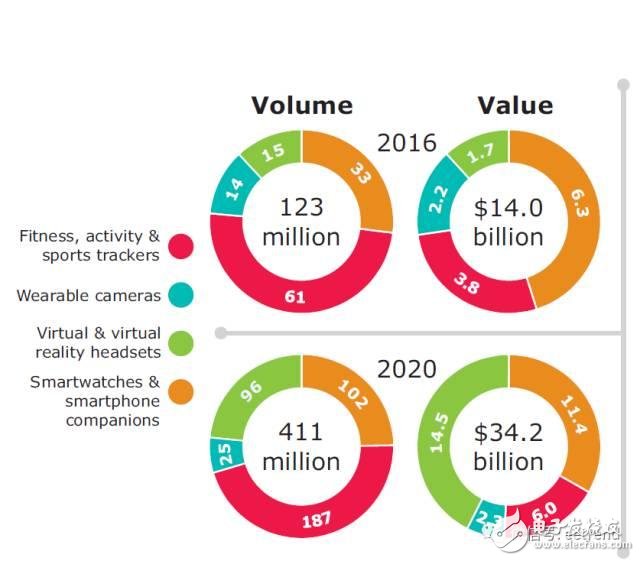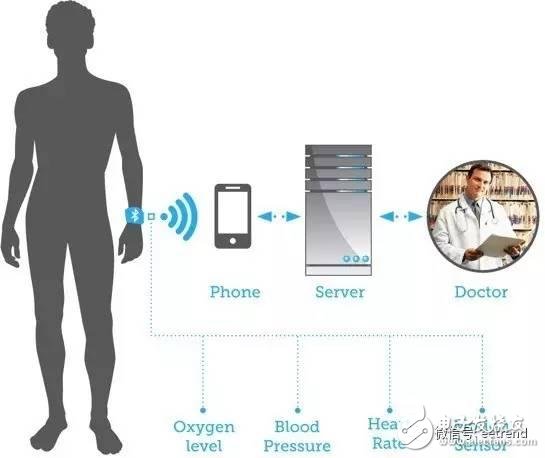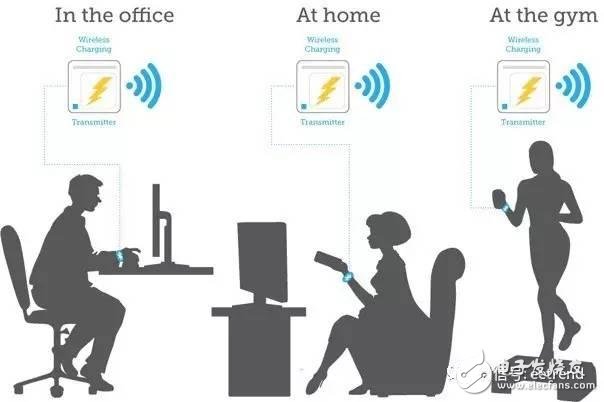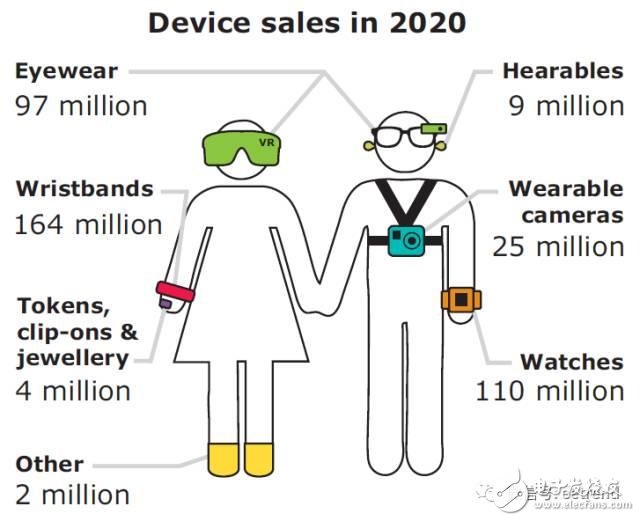Smart wearer
Wearables enable us to improve every aspect of our lives, such as productivity, health and lifestyle, in ways never before possible. They track our own situation and the surrounding environment and provide relevant information to inspire us to be motivated or to encourage us to make better choices. Moreover, they can also help with personal connections and connect the “digital self” to the Internet. This allows us to share information with friends or remote diagnostic experts, whether for fun, solicitation and advice, or on-site medical diagnosis.
Therefore, the rapid development of the wearable device market is not surprising. According to market research, shipments of wearable devices in 2014 were 29 million, compared with 85 million in 2015. At the same time, the company predicts that the market for wearable devices will reach 123 million in 2016 and 411 million in 2020.
Figure 1: Analytical companies predict that all areas of the wearables market will grow rapidly in the coming years.
Although the initial growth of the wearable device market is encouraging, the overall market size is still relatively small, especially compared to the smartphone market with annual shipments of more than one billion units. To drive this fast-growing market to its full potential, we need exciting new wearable devices.
These devices will integrate more sensors to provide users with more useful information and context-aware features to ensure that information is delivered in a corresponding manner. They will open up new uses, such as diluting the boundaries between consumption and medical applications, helping people manage their health with the help of medical professionals. These new uses will make data security and user privacy even more important.
Wearables only work when people wear it, and the longer they wear, the better. Therefore, these next-generation devices need to provide long battery life (ie, the time between charges), while requiring a "low-key" shape and comfortable wear.
Data integration and context awareness
The earliest wearable devices were simple pedometers based on 3D accelerometers. More complex devices containing devices such as pressure sensors and gyroscopes soon followed. These devices enable wearable devices to identify the type of activity the wearer is participating in (such as walking, running, climbing, etc.) and track their sleep cycles. At the same time, the temperature and humidity sensors enable the wearable device to more accurately measure parameters such as calories burned during exercise.
This trend of integrating more sensors into wearable devices will accelerate in the next few years. In particular, we will see more and more integrated motion and environmental sensors, as well as emerging biosensors. Biosensors are now available in stand-alone wearable medical monitors, and many consumer devices now offer heart rate measurement. But in the next few years, consumer devices will integrate a wider range of biosensors, such as spectral sensors that measure blood oxygenation, blood pressure and blood sugar levels, and skin resistance sensors that determine sweat levels and pH.
Figure 2: We will see biosensors that are increasingly integrated with wearable devices.
There are many advantages to integrating more sensors, and the most obvious is that you can increase the functionality of the device to enable it to measure more parameters. In addition, the accuracy of the collected data can be improved. For example, using information from other sensors to determine the type of activity the wearer is engaged in helps to select a more appropriate algorithm to process input from the accelerometer, making activity tracking more accurate. In addition, combining data from numerous sensors enables the device to extract more information useful to the user, for example, using heart rate, accelerometer data, and skin resistance sensing to measure a person's stress level.
In addition to the sports, environmental and biosensors mentioned above, it is also possible for wearable devices to increase the use of microphones. But the goal is not to provide the wearer with more information, but to help the device perceive its usage context in order to determine what information is useful to the wearer and how to deliver the information in an optimal manner. For example, if the device "hears" the roar of a jet engine, it can infer that the wearer is flying, monitor how long it has been sitting, and then adjust the recommendations for sleep and exercise to help the wearer cope more effectively. , dehydration and jet lag.
New use
As wearable devices collect more data about us and the surrounding environment, they will increasingly become our “digital self”. This, combined with wearable devices and context-aware mash-ups, opens up many new uses for wearable devices. The possibilities are almost endless. But it is easy to imagine that wearable devices will become universal access devices, such as opening doors, office doors and car doors, logging in to work systems, and so on. This avoids the hassle of forgetting to bring keys, pass and forget your password.
In the field of home automation, smart entertainment systems are able to detect who is at home through a wearable device and automatically select TV channels, music, and volume based on that person's preferences. Wearables can communicate with beacons everywhere in the room, sense the presence of people, turn lighting and heating on and off, and adjust to individual preferences, so you always feel comfortable and save energy.
Big data: diluting the boundaries between consumption and medical applications
The most exciting new use of licensed devices is also to help people manage their health. As the number of biosensors used increases and the accuracy and reliability of the data collected increases, we will see convergence in consumer and medical applications. Fitness and lifestyle devices will evolve from consumer devices to providing medical-grade data.
Therefore, the information you collect to track health and exercise levels can be shared with your doctor or automated medical monitoring system to provide early warning before symptoms appear. This allows people to seek treatment or change lifestyles early when the situation is not too serious, easier to implement, and more likely to succeed.
Many companies are currently developing data-sharing cloud infrastructure for healthcare, which is a natural partner for these infrastructures. This will be the area in which we witness the true power of big data. As wearable devices become more common and advanced, we will be able to organize and analyze anonymous, health, fitness and lifestyle information from millions of people. In addition to revealing deep health trends, these huge data sets can also reveal how disease occurs (so-called “super early medical care”). This helps early intervention to minimize the financial, social and personal impact of the disease.
User privacy and security
As wearable devices collect more and more sensitive information and become a full digital self, privacy and data security will become critical. Especially in the case of medical data, consumers will require the highest level of data security, and as consumers become more informed, this will be a key factor influencing purchase decisions.
The storage and transmission of data must be secured. The first generation of networked wearable devices mostly relied on the inherent security protocols of their chosen connection technology, such as Bluetooth low energy (BLE). If you just track how many people have gone in a day, this may be enough. But if consumers entrust their medical information to wearables, they need stronger security measures.
The latest version of the Bluetooth standard (Bluetooth 4.2) provides greater security. However, due to the large number of Bluetooth devices, the risk of security algorithms being compromised by hackers (making data transmissions unsafe) always exists.
Therefore, wearable device manufacturers must consider independent data encryption measures, such as Dialog's approach to wearable device solutions. Even if the Bluetooth security protocol is cracked, the transmitted data is still encrypted. In this way, manufacturers can provide consumers with end-to-end security independent of Bluetooth technology, giving personal information on wearable devices the same level of security as bank financial records.
Battery life
The limited power of button cells and rechargeable batteries poses significant challenges for wearable device manufacturers when integrating more sensors and supporting new applications. IDC and GMI research has repeatedly shown that battery life has become the number one consideration for consumers to purchase battery-powered convenience products.
Current wearable devices typically provide approximately 7-14 days of battery life/charge cycle. As devices become more complex, consumers hope that this endurance will at least be maintained, and of course it will be better. In addition, many uses of wearable devices require long-term continuous monitoring, and if the device has to be removed for charging or battery replacement, the benefits of the application are offset, thereby reducing their appeal to consumers. For example, if you have to charge your device at night, your device won't be able to track your sleep patterns, and you may miss out on finding a heart condition, which could be a warning sign of a serious heart attack.
Typical lithium polymer rechargeable batteries have a capacity of only 40 - 100 mAh. In this case, powering a wearable device containing multiple sensors for a few days means reducing the power consumption of all components of the system, including sensors, systems, communication hardware, and software. Sensor technology is constantly evolving and reducing power requirements. At the same time, Dialog continues to make progress in total system power consumption through Bluetooth low-power SoCs (such as the new SmartBond DA14680 and DA14681) that integrate application and communication hardware. Thanks to innovative power management and RF technology, these products consume only about 1 mA of current consumption under typical Bluetooth events.
Holy Grail: Wearable device that never leaves
The ultimate goal of wearable devices is to achieve continuous monitoring. This means finding a way to power the device without having to remove it for charging (or replacing the battery). Two obvious methods are energy harvesting and wireless charging.
For energy harvesting, the most promising candidate technologies are photovoltaic cells and the collection of spurious RF signals. Vibration energy harvesting and thermoelectric power generation are also possible, but since the frequency of human movements and the temperature difference around the human body are limited, this means that its potential is very limited. Some manufacturers have begun to study the application of energy harvesting in wearable devices. For example, Misfit has partnered with Swarovski to develop and produce solar-powered health monitoring jewelry. However, as our functional requirements for wearable devices continue to increase, it seems that energy harvesting is difficult to become the only power source for wearable devices that are always on, and may act as an auxiliary power source to help extend the battery life of the main battery.
Wireless charging has the potential to become the main power source. Since wearable devices need to be worn on the body, the most promising option is loosely coupled wireless charging, where RF signals power multiple independent devices in an extended area, similar to Wi-Fi systems to wirelessly connect multiple devices with Internet connection. Dialog and Energous recently demonstrated the first proof of concept for this system with a charging radius of up to 10 meters.
Figure 4: Loosely coupled wireless charging can support the development of wearable devices that do not need to be removed.
In order for wireless charging to truly become the primary source of wearable devices that are always on, a significant investment in the charging infrastructure is required. Wi-Fi can be used as a model; charging systems can be installed at home and in the workplace, while coffee shops, airports, hotels, etc. can make them more advantageous than competitors by creating larger "charging hotspots" for customers.
shape
Another challenge faced by wearable device manufacturers is to put all of these features into devices that people have to wear for a long time. Different people have different appearance preferences for wearable devices. Some people like fashion, while others like low-key.
Currently, the most common wearable device shapes are bracelets and smart watches. According to preliminary market research by market research firm Forrester, these shapes will still be among the most popular profiles, with 28% of people willing to wear fun and reliable sensor devices on their wrists. As shown in Figure 5, the wrist should still be the most commonly worn place for wearable devices in the next few years, but we will see some different types of devices appear. One thing these devices are all the same is that they all have a very small form factor.
發送反饋
歷史記錄
Figure 5: Although wearable devices worn on wrists by 2020 will still be the most common, many other types of small devices will become popular.
To make these small devices, manufacturers need more integrated hardware solutions; SoC solutions provide all applications, systems, security and personal connectivity in a single package. Currently, the smallest solution (containing one SoC and all necessary passive components in a single module) is approximately 3.5 x 3.5 mm. To meet future form factor requirements, the size of these solutions needs to be further reduced.
IC companies that supply components to wearable device manufacturers can cater to these trends by increasing the functionality integrated into their IC solutions. For example, Dialog's SmartBond DA1468x family combines communications, application processing, sensing hub and power management functions. This eliminates the need for peripheral battery chargers, fuel gauges, DC/DC converters, etc., which helps to save board space.
Ready for the future
Comfortable and advanced multi-sensor wearables have the potential to help people improve their lives in all directions. But to truly realize this potential, wearable device manufacturers need to combine devices with services that are fun and useful to consumers. The possibilities for these services are almost endless – from telemedicine inspections to helping people make healthy eating choices, to home automation and more. These services will encourage people to buy and use wearable devices, driving this young market to continue its exciting growth rate at an early stage and gradually mature.
To implement these devices and services, wearable device manufacturers need chip solutions that extend the capabilities of the device while meeting unique device size and power constraints. Dialog Semiconductor is committed to providing these solutions through its SmartBond product line and has an innovative roadmap that keeps pace with the evolution of industry demand.
The SmartBond DA14680 and DA14681 are the first steps on this roadmap. As the first single-chip solution for wearables, smart homes and other charging devices, they combine superior performance, high integration and low power consumption to enable design engineers to develop charging cycles to satisfy users. The only integrated solution for a complete multi-sensor wearable device with context awareness. As a result, the DA14680 and DA14681 help create the next generation of Bluetooth low-power wearables that will drive this emerging market to its full potential.





